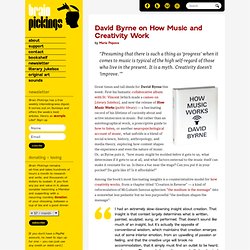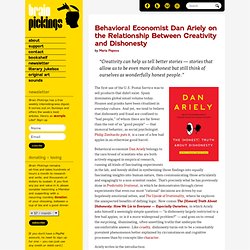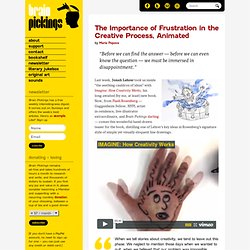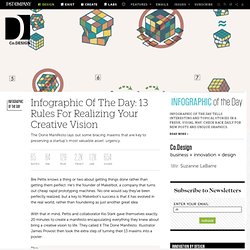

David Byrne on How Music and Creativity Work. By Maria Popova “Presuming that there is such a thing as ‘progress’ when it comes to music is typical of the high self-regard of those who live in the present.

It is a myth. Creativity doesn’t ‘improve.’” Great times and tall deeds for David Byrne this week: First his fantastic collaborative album with St. Vincent (which made a cameo on Literary Jukebox), and now the release of How Music Works (public library) — a fascinating record of his lifetime of curiosity about and active immersion in music. Behavioral Economist Dan Ariely on the Relationship Between Creativity and Dishonesty. By Maria Popova “Creativity can help us tell better stories — stories that allow us to be even more dishonest but still think of ourselves as wonderfully honest people.”

The first use of the U.S. Postal Service was to sell products that didn’t exist. Spam dominates global email volume today. Hoaxes and pranks have been ritualized in everyday culture. Behavioral economist Dan Ariely belongs to the rare breed of scientists who are both actively engaged in empirical research, running all kinds of fascinating experiments in the lab, and keenly skilled in synthesizing those findings into equally fascinating insights into human nature, then communicating those articulately and engagingly to a non-scientist reader.
Ariely writes in the introduction: In addition to exploring the forces that shape dishonesty, one of the main practical benefits of the behavioral economics approach is that it shows us the internal and environmental influences on our behavior. How We Measure the Universe, Animated. Donating = loving Brain Pickings remains ad-free and takes hundreds of hours a month to research and write, and thousands of dollars to sustain.

If you find any joy and value in it, please consider becoming a Member and supporting with a recurring monthly donation of your choosing, between a cup of tea and a good dinner: (If you don't have a PayPal account, no need to sign up for one – you can just use any credit or debit card.) John Cleese on the 5 Factors to Make Your Life More Creative. The Importance of Frustration in the Creative Process, Animated. By Maria Popova “Before we can find the answer — before we can even know the question — we must be immersed in disappointment.”

Last week, Jonah Lehrer took us inside “the seething cauldron of ideas” with Imagine: How Creativity Works, his long-awaited (by me, at least) new book. Now, from Flash Rosenberg — Guggenheim Fellow, NYPL artist-in-residence, live-illustrator extraordinaire, and Brain Pickings darling — comes this wonderful hand-drawn teaser for the book, distilling one of Lehrer’s key ideas in Rosenberg’s signature style of simple yet visually eloquent line drawings.
When we tell stories about creativity, we tend to leave out this phase. We neglect to mention those days when we wanted to quit, when we believed that our problem was impossible. For a related treat, see Rosenberg’s live-illustration of John Lithgow reading Mark Twin at the New York Public Library. The Social Network for Creatives, by Creatives. The Creative Finder is a site from the creators of popular daily creativity and innovation news site, designtaxi.com.

Around since 2009, the site dubs itself as a global search engine for creatives, aiming to connect people for business, networking or just collaboration. Creator Alex Goh just launched a new edition of the site, which not only integrates with existing social networks like Tumblr and Pinterest - where many creatives choose to host imagery outside of the standard Facebook and Twitter spaces - it also offers a way for users dubbed "finders" to locate creative types for commission-based work. If Facebook is a space to display the finished product in front of a willing audience, then the Creative Finder is a network for discovering the people who will help you make that product. I mostly use Facebook to network with writers, artists and people in the arts, so I curated my profile on The Creative Finder with the same imagery. Jonah Leher On The Three Types Of Creativity And How Brainstorming Doesn't Work.
Six Vintage-Inspired Animations on Critical Thinking. Infographic Of The Day: 13 Rules For Realizing Your Creative Vision. Bre Pettis knows a thing or two about getting things done rather than getting them perfect: He’s the founder of Makerbot, a company that turns out cheap rapid prototyping machines.

No one would say they’ve been perfectly realized, but a key to Makerbot’s success is that it has evolved in the real world, rather than foundering as just another great idea. With that in mind, Pettis and collaborator Kio Stark gave themselves exactly 20 minutes to create a manifesto encapsulating everything they knew about bring a creative vision to life. They called it The Done Manifesto. Illustrator James Provost then took the extra step of turning their 13 maxims into a poster: They are: There are three states of being. At first glance, this list seems a little hyperbolic or silly: If you’re used to startup culture, you’ve been there, done that. I’ve been watching this firsthand lately, as a friend of mine has been trying to get an iPhone app company off the ground.